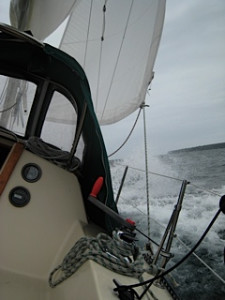Many of you know that sailing is a passion of mine, and my belief that it is a powerful metaphor and venue for teamwork and leadership development. Two years ago I sold our sloop Loon, which for years provided many adventures and leaning opportunities sailing the Great Lakes. In search of new sailing opportunities, I recently joined the Twin Cities Sailing Club, which owns a fleet of racing scows and day sailers on Lake Harriet in Minneapolis, all under 18 feet. My re-introduction to the world of smaller boats and transition from a 20,000-pound keel boat is serving up some new lessons and reinforcing older ones.
Transitioning from bigger to smaller sailboats, I couldn’t help comparing large organizations with smaller ones. The fundamentals of sailing are the same for big or small sailboats: wind propels both, just as  revenue and profit propel both small and large organizations. They follow the same general rules; for example maritime right-of-way rules apply to all boats, and FASB rules apply to all corporations. Just as for big and small boats, big and small organizations employ the same basic tools and methods; all sailors employ tried-and-true knots, halyards, sheets and basic sail-trimming techniques; large and small businesses alike employ traditional accounting methods, information technology and social media. There are also some critical differences between sailing large boats and small boats, which if unknown or ignored can imperil boats (organizations,) skippers (leaders) and crew (employees.)
revenue and profit propel both small and large organizations. They follow the same general rules; for example maritime right-of-way rules apply to all boats, and FASB rules apply to all corporations. Just as for big and small boats, big and small organizations employ the same basic tools and methods; all sailors employ tried-and-true knots, halyards, sheets and basic sail-trimming techniques; large and small businesses alike employ traditional accounting methods, information technology and social media. There are also some critical differences between sailing large boats and small boats, which if unknown or ignored can imperil boats (organizations,) skippers (leaders) and crew (employees.)
Bigger sailboats are heavier, broader and most significantly have a large lead-filled keel, the primary factor contributing to the unlikelihood of going bottoms-up in heavy seas; in moderate seas they are more forgiving and safer than small sailboats. Likewise, large organizations have more heft than their smaller counterparts, including financial reserves and credit lines; as a consequence they too can be more forgiving of strategic or tactical errors. A bad gybe in large sailboats would be awkward and perhaps damage minor fittings; a bad gybe in a day sailer or scow would likely knock crew off the boat (inflicting head wounds in the process) and capsize it. Of course in heavy seas or turbulent markets, even large sailboats or corporations can get in trouble, and the consequences are proportionally more serious. There are trade-offs; the same lead-filled keel of a large sailboat that provides more stability and safety also slows it down; smaller sailboats are more responsive and can be much faster. While heavy sailboats with deep drafts are good for crossing oceans, the much shallower drafts of small boats allow them to explore interesting shallow bays and inlets. There are different boats for different purposes, just as there are different organization designs for different purposes.
Some skills and practices that served me well aboard Loon on Lake Superior were of no use sailing smaller  boats on Lake Harriet; in some cases they got in the way. An example is wheel vs. tiller steering; when turning a ship’s wheel to the right, she heads starboard, but heading starboard with a tiller means pulling or pushing it to the left. (Which for the first few outings makes for some awkward maneuvers!) Likewise there are skills and practices that make perfect sense in a giant multinational corporation, but that would be useless or counter-productive in a smaller or start-up company. Just because we’ve developed strong skills in one context, it pays to not assume they apply equally well in a new one. Each requires different sets of skills and capabilities – not better, just different. Humility, observation and the spirit of a learner are required to succeed when making transitions.
boats on Lake Harriet; in some cases they got in the way. An example is wheel vs. tiller steering; when turning a ship’s wheel to the right, she heads starboard, but heading starboard with a tiller means pulling or pushing it to the left. (Which for the first few outings makes for some awkward maneuvers!) Likewise there are skills and practices that make perfect sense in a giant multinational corporation, but that would be useless or counter-productive in a smaller or start-up company. Just because we’ve developed strong skills in one context, it pays to not assume they apply equally well in a new one. Each requires different sets of skills and capabilities – not better, just different. Humility, observation and the spirit of a learner are required to succeed when making transitions.
Transitions between large and small boats, just like transitions between large and small organizations, offer opportunities to learn new skills or refine existing skills to a level not required previously. Sailing small boats has sensitized me more to subtle changes in wind direction or speed, and helped me trim sails to take full advantage of what wind there is. Likewise, successfully running a small business often requires superior sensitivity to shifting market conditions and speed reacting to them. Leaders of large organizations can rely on others and their organizations’ significant resources to get out of tight spots or close a sale, just as skippers of big sailboats can call on crew and employ auxiliary engines when needed. (I have to admit that as both skipper of a daysailer or scow and a “solopreneur” I often miss having crew and auxiliary power!)
Large boat / large organization or small boat / small organization, learning and the quality of coaching play critical roles. We cannot competently sail any boat or lead any organization by just reading books or taking classes. Neither sailing theory or leadership theory is like actually sailing or leading; the principles are a foundation, but practicing the principles in diverse conditions, making errors and learning from them are what build competence and confidence. I’ve made a few observations of teaching and coaching practices that have made me a better sailor; I believe that they apply to developing leaders as well:
- It’s about the learner and learning goals. What will skippers / leaders actually have to do, under what conditions? What is the learner’s current level of knowledge and competence compared to requirements? It’s helpful when coaches recognize what learners already know and do well, without wasting time explaining everything that the coach wants to explain.
- Observation and feedback: I can tell by the results when I’ve tacked or gybed poorly; the best coaches can tell me what they observed and specific things I did, didn’t do or did poorly that led to poor results. They are also good at not only explaining what to do or how to do it, but why.
- First things first, and pace: Start with the big picture and fundamentals as needed, including ways to stay safe. Build on the foundation and avoid information overload.
- Support and relationship-building: Since the Twin Cities Sailing Club is also social, this seems to come naturally for most. Some coaches are better than others offering advice and correcting errors while building a relationship instead of diminishing it.
- Allow mistakes; they can be the best teachers. Paraphrasing one of my sailing coaches, he likes to give us enough rope (actually “line” on a boat,) but not enough to hang ourselves – or the crew. Mistakes that lead to a little embarrassment or even a dunk are OK, but not mistakes that endanger the boat or crew.
- Teaching is great learning. I remember that coaching others aboard Loon and teaching boating safety for the Coast Guard Auxiliary helped me retain existing skills and learn new ones. Twin Cities Sailing Club coaches report that they find the same to be true.
Are you a “big boat” (big organization) or “small boat” (small organization) person; which are you best suited for?
Making a transition from a small to a large or from a large to a small organization, what would some key adjustments for you be? How might you prepare for those and manage the transition?
Whatever transitions you are making or new skills you hope to acquire, what will you need to leave behind? How else can you accelerate your learning and successful transition?
Large boat or small, learning to sail and sailing adventures can be powerful platforms for personal, leadership and team development. inTEgro is now partnered with Sail Pepin in Pepin, Wisconsin, to offer you those opportunities; check out SeaChange Ventures to learn more and to begin planning your sailing adventure.
The pessimist complains about the wind, the optimist expects it to change, and the realist adjusts the sails.
William Arthur Ward
It is not the ship so much as the skillful sailing that assures a prosperous voyage.
George William Curtis
There are some things you learn best in calm, and some in storm.
Willa Cather
Navigating the challenges of emotional well-being can have direct implications on one’s physical health. Numerous studies have pointed out the intriguing link between Depression and Weight Loss. While some individuals might lose weight due to decreased appetite or increased anxiety, others might experience weight gain due to overeating as a coping mechanism. Understanding these dynamics is essential for comprehensive health management. Depression and weight loss






